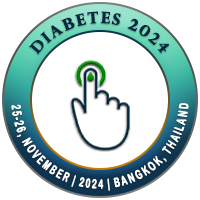
Nitu Nigam
K.G’s. Medical University, IndiaTitle: Effect of raja yoga meditation on glycaemic status in type 2 diabetes mellitus
Abstract
In this modern era stress is a
commonly seen phenomenon. Stress affects physiological equilibrium leading to
many pathologic conditions including endocrine disorders like diabetes
mellitus. Type 2 diabetes (DM2) has become a leading public health issue globally,
with estimated 366 million people affected in 2011. DM2 is typified by
hyperglycaemia in the presence of insulin resistance.6 Other key related
hemodynamic and metabolic abnormalities characterizing DM2 include elevated
blood pressure, dyslipidemia, and chronic inflammation, as well as
hypercoagulation and increased oxidative stress. Lifestyle factors,
particularly, physical inactivity, overnutrition, and related obesity, are
thought to be primarily responsible for the current global diabetes epidemic.
Other contributing lifestyle-related factors include chronic stress, impaired
sleep, and smoking. Physiological responses to stress including increased
glucose production, glucose mobilisation and insulin resistance could partially
mediate this risk. Meditation is a behavioural phenomenon which can be used to
cause autonomic nervous system alterations and help in reducing stress and its
effects.
Yoga-based practices may have
significant beneficial effects on many factors important in DM2 management and
prevention, including glycaemic control and lipid profiles. Raja yoga
meditation is a superior form of meditation in which flow of thoughts is encouraged
by using the mind in a natural way to relieve stress. Yoga practices can
influence outcomes in those with and at risk for type 2 diabetes (DM2). Yoga
may lessen the negative impact of stress and promote multiple positive
downstream effects on metabolic function, neuroendocrine status, and related
inflammatory responses and, ultimately, reduce risk for CVD and other vascular
complications, by enhancing well-being and reducing reactivity and activation
of the HPA axis and the sympathoadrenal system.
Thus, Raja yoga meditation can
form an important supplementary therapy in conjunction with conventional
therapeutic measures for T2DM.
Biography
Dr Nitu Nigam has received Ph.D
(Medical Genetics) from Sanjay Gandhi Institute of Medical Sciences, Lucknow in
2003. She did postdoctoral training in cancer genetics from USA. Dr Nigam has
joined Cytogenetics lab of Department of CFAR in 2016.She has more than 40
international and national publication. She has been serving editorial board
member of several journal.
A
major research focus of lab is to identify and characterize an increased
genetic risk or a genetic diagnosis can substantially impact medical management
as well as the psychological and social well-being of the patient and family. Her
lab also focuses to identify and characterize the molecular players in
chromosomal aberrations pathways. For this she conducts the genetic screening
of affected families in population and utilizes cellular /animal models for
testing and validating the hypothesis.

